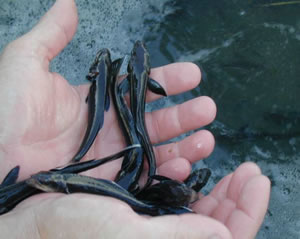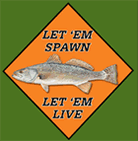Cobia Stock Enhancement

Cobia are a coastal migratory pelagic species with an annual spring run in South Carolina waters from April through July. In the late 1980’s and early 90’s the recreational fishery for cobia in South Carolina saw exponential growth as inshore anglers began to target cobia for their size, accessibility and fine table fare. It was theorized that cobia moved into the high salinity estuaries of southern South Carolina to feed during their long migration from overwintering grounds in Florida to their spawning grounds in Chesapeake Bay; however very little was known about the life history of this transient species. The sudden popularity of this fishery sparked concerns about overfishing among the angling community of Beaufort County. In order to better understand the wild population, fisheries managers developed a pilot-scale stocking program to answer scientific questions about cobia and determine if stock enhancement could be used as a tool to augment the wild population. Outside of anadromous species such as salmon and striped bass, no stock enhancement efforts with a migrating marine species had been attempted and it seemed likely that a small number of hatchery fish (fig. 1) released into this migrating cobia population would never be seen again.
To begin the stocking program, adult cobia were captured in the Broad River and transported to tanks at the Waddell Mariculture Center in Bluffton, South Carolina where they were used as brood stock for hatchery production. Researchers discovered that the cobia in the Broad River were in spawning condition and could be induced to spawn within days of capture. Eggs and larvae from these spawns were reared in outdoor ponds at the Waddell Center, grown to target size in the hatchery, and then released in the Broad or Colleton River. Between 2001 and 2009, a total of 64,768 hatchery raised cobia (table 1) were released in Port Royal Sound.
Table 1. Cobia fingerlings releases in South Carolina
| Year Class | # Released | Release Location |
|---|---|---|
| 2001 | 1,543 | Broad River |
| 2004 | 1,905 | Colleton River |
| 2005 | 4,142 | Colleton River |
| 2007 | 53,732 | Colleton River |
| 2008 | 2,054 | Colleton River |
| 2009 | 1,392 | Colleton River |
The migratory nature of cobia provided a number of challenges to researchers when analyzing the impact of stocking on the wild cobia population. Cobia have a minimum harvestable size limit of 33” fork length, which they reach in their third year. Thus, cobia do not recruit to the fishery for three years, creating a lag in tag return data. Additionally, cobia are only available to inshore anglers in South Carolina during the two months of their spring migration. The lag in recruitment, combined with the limited availability of the species, drastically reduced the odds of recapturing one of the small number of hatchery fish released.
As a way to increase the odds of finding cobia recaptures, researchers began to apply genetic identification techniques developed for red drum stocking. Genetic identification is a technique that matches DNA markers of a captured fish against the known DNA markers present in their broodstock parents. This process has number of advantages over traditional marking techniques. Because genetic identification uses DNA, there is no tag loss or tag shedding; the mark is permanent and can be followed throughout the life of the fish. Secondly, DNA is matched from a small piece of fin tissue called a fin clip. Fin clips do not require the fish to be sacrificed and can therefore be taken from any sized cobia. Finally, fish are sampled randomly producing a ratio of hatchery to wild fish called hatchery contribution. Traditional tagging techniques only provide data on tag recaptures and provide no data on the number of untagged wild fish captured.
The results of the pilot stocking program were surprising. Genetic analysis revealed hatchery fish in every year sampled. In 2007, a total of 340 fin clips were collected and three matched broodstock parents used in 2004 and 2005. This means that the 2,448 hatchery fish released in 2004 and 2005 made an overall contribution of 0.9% to the entire wild population in South Carolina in 2007. In 2007, over 53,000 hatchery cobia were released and they began to recruit in 2009. Contribution of hatchery fish rose from 0.6% in 2008 to 2.7% in 2009 and then to 7.3% in 2010, the first year of full recruitment (table 2). When hatchery fish from the 2007 year class were compared with only other wild cobia born in 2007, contribution soared to 23.4% in 2010. Not only had the hatchery fish survived 3 years of traveling up and down the Atlantic seaboard, but they had returned to South Carolina and made a significant contribution to the wild population. Hatchery returns by location revealed further information about these fish. Of the 32 hatchery returns with known capture locations, over 78% were captured within the Broad River. The remaining 22% were captured offshore of South Carolina with only one return from offshore Georgia.
Table 2. Overall contribution of hatchery cobia to the wild population in South Carolina.
| Sampling Year | Total (n) | Wild (n) | Hatchery (n) | Contribution (%) |
|---|---|---|---|---|
| 2007 | 340 | 337 | 3 | 0.9 |
| 2008 | 345 | 343 | 2 | 0.6 |
| 2009 | 221 | 215 | 6 | 2.7 |
| 2010 | 261 | 242 | 19 | 7.3 |
| 2011 | 274 | 261 | 13 | 4.7 |
The surprising results of the SCDNR pilot scale cobia stock enhancement project provided important information to fisheries managers in South Carolina. Even though cobia are a marine migratory species, hatchery-raised cobia can make a contribution to the population and could be used as a tool to augment the wild population should overfishing become a problem. In addition, cobia adults collected in the Broad River were in spawning condition at the time of collection and may be entering the estuary to spawn rather than feed. Finally, hatchery fish released into Port Royal Sound as small fingerlings returned upon reaching sexual maturity, leading to speculation that, like salmon and striped bass, cobia may return to their natal estuary to spawn. These findings have important implications for fisheries managers seeking to identify critical spawning habitat for cobia.



